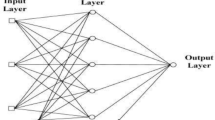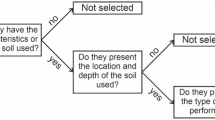Abstract
The diagnosis of saline soils requires the analysis of electrical conductivity in saturated soil paste extract. Its analysis is expensive, tedious, and highly time-consuming, therefore, commercial laboratories analyze the aqueous extract in a 1:1 ratio and then transform the value into saturation extract using equations. The research aimed to calibrate a statistical learning method to predict the electrical conductivity adapted to Peruvian conditions. For this, we apply different models from highly interpretable to black-box, such as multiple linear model, generalized additive models, Bayesian additive regression tree, extreme gradient boosting trees, and neural networks. In general, the models with beast predictive power were neural network and extreme gradient boosting trees, and the beast interpretable was Bayesian additive regression trees. The generalized additive models present the best balance between prediction power and interpretability with low application on extremely salty soils.
Access this chapter
Tax calculation will be finalised at checkout
Purchases are for personal use only
Similar content being viewed by others
References
Aboukila, E.F., Norton, J.B.: Estimation of saturated soil paste salinity from soil-water extracts. Soil Sci. 182(3), 107–113 (2017). https://doi.org/10.1097/ss.0000000000000197
Benke, K.K., Norng, S., Robinson, N.J., Chia, K., Rees, D.B., Hopley, J.: Development of pedotransfer functions by machine learning for prediction of soil electrical conductivity and organic carbon content. Geoderma 366 (2020). https://doi.org/10.1016/j.geoderma.2020.114210
Bleich, J., Kapelner, A., George, E.I., Jensen, S.T.: Variable selection for BART: an application to gene regulation. Ann. Appl. Stat. 8(3) (2014). https://doi.org/10.1214/14-aoas755
Buuren, S.v., Groothuis-Oudshoorn, K.: mice: Multivariate imputation by chained equations in R. J. Stat. Softw. 45(3) (2011). https://doi.org/10.18637/jss.v045.i03
Bzdok, D., Altman, N., Krzywinski, M.: Statistics versus machine learning. Nat. Meth. 15(4), 233–234 (2018). https://doi.org/10.1038/nmeth.4642
Camacho-Sandoval, J.: Coeficiente de concordancia para variables continuas. Acta Médica Costarricense 50, 211–212 (2008)
Chandola, V., Banerjee, A., Kumar, V.: Anomaly detection. ACM Comput. Surv. 41(3), 1–58 (2009). https://doi.org/10.1145/1541880.1541882
Chi, C.M., Wang, Z.C.: Characterizing salt-affected soils of songnen plain using saturated paste and 1:5 soil-to-water extraction methods. Arid Land Res. Manage. 24(1), 1–11 (2010). https://doi.org/10.1080/15324980903439362
Chipman, H.A., George, E.I., McCulloch, R.E.: BART: Bayesian additive regression trees. Ann. Appl. Stat. 4(1) (2010). https://doi.org/10.1214/09-aoas285
Daliakopoulos, I.N., Tsanis, I.K., Koutroulis, A., Kourgialas, N.N., Varouchakis, A.E., Karatzas, G.P., Ritsema, C.J.: The threat of soil salinity: a European scale review. Sci Total Environ. 573, 727–739 (2016). https://doi.org/10.1016/j.scitotenv.2016.08.177
El hasini, S., Halima, O.I., El. Azzouzi, M., Douaik, A., Azim, K., Zouahri, A.: Organic and inorganic remediation of soils affected by salinity in the sebkha of sed el mesjoune - marrakech (morocco). Soil Tillage Res. 193, 153–160 (2019). https://doi.org/10.1016/j.still.2019.06.003
FAO: Guidelines for soil de-scription. FAO, Rome (2006)
Gamboa, N.R., Marchese, A.B., Tavares Corrêa, C.H.: Salinization in Peruvian North Coast Soils: Case Study in San Pedro de Lloc, book section Chapter 7, pp. 141–159 (2021). https://doi.org/10.1007/978-3-030-52592-7
Hogg, T.J., Henry, J.L.: Comparison of 1:1 and 1:2 suspensions and extracts with the saturation extract in estimating salinity in saskatchewan soils. Canadian J. Soil Sci. 64(4), 699–704 (1984). https://doi.org/10.4141/cjss84-069
INEI: 4to censo nacional agropecuario (17/08/2021 2012). http://censos.inei.gob.pe/cenagro/tabulados/
James, G., Witten, D., Hastie, T., Tibshirani, R.: An Introduction to Statistical Learning. Springer Texts in Statistics. Springer (2021). https://doi.org/10.1007/978-1-4614-7138-7
Kapelner, A., Bleich, J.: bartMachine: machine learning with Bayesian additive regression trees. J. Stat. Softw. 70(4) (2016). https://doi.org/10.18637/jss.v070.i04
Kargas, G., Chatzigiakoumis, I., Kollias, A., Spiliotis, D., Massas, I., Kerkides, P.: Soil salinity assessment using saturated paste and mass soil: water 1:1 and 1:5 ratios extracts. Water 10(11) (2018). https://doi.org/10.3390/w10111589
Kuhn, M.: Building predictive models in rusing the caret package. J. Stat. Softw. 28(5) (2008). https://doi.org/10.18637/jss.v028.i05
Landon, J.R.: Booker Tropical Soil Manual (2014). https://doi.org/10.4324/9781315846842
Legros, J.: Major Soil Groups of the World: Ecology, Genesis, Properties and Classification. CRC Press, Boca Raton (2012)
Lin, L.I.K.: A concordance correlation coefficient to evaluate reproducibility. Biometrics 45(1) (1989). https://doi.org/10.2307/2532051
Ma, G., Ding, J., Han, L., Zhang, Z., Ran, S.: Digital mapping of soil salinization based on sentinel-1 and sentinel-2 data combined with machine learning algorithms. Regional Sustain. 2(2), 177–188 (2021). https://doi.org/10.1016/j.regsus.2021.06.001
Matthees, H.L., et al.: Predicting soil electrical conductivity of the saturation extract from a 1:1 soil to water ratio. Commun. Soil Sci. Plant Anal. 48(18), 2148–2154 (2017). https://doi.org/10.1080/00103624.2017.1407780
Mayer, M.: outForest: multivariate outlier detection and replacement (2021). https://CRAN.R-project.org/package=outForest
Miura, K.: Nitrogen and Phosphorus Nutrition Under Salinity Stress, book section Chapter 16, pp. 425–441 (2013). https://doi.org/10.1007/978-1-4614-4747-4
Omuto, C., Vargas, R., El Mobara, A., Mohamed, N., Viatkin, K., Yigini, Y.: Maping of salt-affected soils: technical manual. FAO, Rome (2020)
Ozkan, H., Ekinci, H., Yigini, Y., Yuksel, O.: Comparison of four soil salinity extraction methods. In: 18th International Soil Meeting on Soil Sustaining Life on Earth, Managing Soil and Technology, pp. 22–26 (2006)
McBratney, A.B., Minasny, B., Stockmann, U. (eds.): Pedometrics. PSS, Springer, Cham (2018). https://doi.org/10.1007/978-3-319-63439-5
RcoreTeam: R: A language and environment for statistical computing (2021). https://www.R-project.org/
Richards, L.: Diagnosis and improvement of saline and alkaline soils. United States Department of Agriculture, Washington (1954)
Sonmez, S., Buyuktas, D., Okturen, F., Citak, S.: Assessment of different soil to water ratios (1:1, 1:2.5, 1:5) in soil salinity studies. Geoderma 144(1–2), 361–369 (2008). https://doi.org/10.1016/j.geoderma.2007.12.005
Sposito, G.: The Chemistry of Soils. Oxford University Press, Oxford, 2 edn. (2008)
Wadoux, A.M.J.C., Malone, B., Minasny, B., Fajardo, M., McBratney, A.B.: Estimating soil properties and classes from spectra, book section Chapter 9, pp. 165–214. Progress in Soil Science (2021). https://doi.org/10.1007/978-3-030-64896-1
Weil, R., Brady, N.: The Nature and Properties of Soils. Pearson, London, 15 edn. (2017)
Zaman, M., Shahid, S.A., Heng, L.: Guideline for Salinity Assessment, Mitigation and Adaptation Using Nuclear and Related Techniques (2018). https://doi.org/10.1007/978-3-319-96190-3
Zhang, H., Schroder, J.L., Pittman, J.J., Wang, J.J., Payton, M.E.: Soil salinity using saturated paste and 1:1 soil to water extracts. Soil Sci. Soc. Am. J. 69(4), 1146–1151 (2005). https://doi.org/10.2136/sssaj2004.0267
Chen, T., Guestrin, C.: XGBoost: a scalable tree boosting system. In: 22nd ACM SIGKDD International Conference on Knowledge Discovery and Data Mining, pp. 785–794 (2016)
Author information
Authors and Affiliations
Corresponding author
Editor information
Editors and Affiliations
Rights and permissions
Copyright information
© 2022 The Author(s), under exclusive license to Springer Nature Switzerland AG
About this paper
Cite this paper
Mestanza, C., Chicchon, M., Gutiérrez, P., Hurtado, L., Beltrán, C. (2022). Prediction of Soil Saturated Electrical Conductivity by Statistical Learning. In: Lossio-Ventura, J.A., et al. Information Management and Big Data. SIMBig 2021. Communications in Computer and Information Science, vol 1577. Springer, Cham. https://doi.org/10.1007/978-3-031-04447-2_27
Download citation
DOI: https://doi.org/10.1007/978-3-031-04447-2_27
Published:
Publisher Name: Springer, Cham
Print ISBN: 978-3-031-04446-5
Online ISBN: 978-3-031-04447-2
eBook Packages: Computer ScienceComputer Science (R0)




